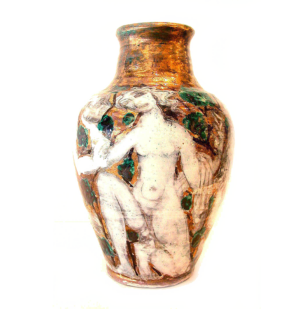(1898-1974)
Literature: Mireille Cazaux, Yvonne Brunhammer, Armand Amann et Marie-Laure Perrin, Edouard Cazaux, céramiste-sculpteur art déco,
Editions Monelle Hayot, 1994.
Edouard Cazaux is one of the most important ceramicists associated with the French Art Deco movement. He was a sculptor and ceramist, who learned his art when he was very young. A formally educated artist, he studied both at l’école des Beaux-Arts and at l’école de Sèvres. His first foray into the world of art, however, was through sculpture. After a few years in Paris, where he had access to the Manufacture de Sèvres, he established himself in La Varenne in 1920, where he built his studio. An excellent turner, Cazaux placed his talents at the service of the Lachenal ceramists before the war, but also of friends such as Jean Mayodon. In1923 Cazaux acted as the secretary of the Salon d’Automne de céramique, and it was only in 1929 that he began to dedicate his time fully to ceramics.
Cazaux’s production is distinguished by his decoration with copper inlays and his original processing of oxides. He explored different techniques, such as the Norton stoneware or the “paste over paste” process. Being influenced by classic Greek sculpture, he gave preference to simple forms before becoming attracted to Cubism, and then developing his own style. His themes include not only Neo-Classical references, but the Far East, and Primitive and African art as well.
What makes Cazaux’s work so distinctive are his vibrant glazes and pictorial techniques. His glazes were achieved by various oxidation methods, and through the use of copper inlays. His pieces are celebrated for their vibrant colors, simple forms and beautiful hand-painted decorations. In 1937, Cazaux was awarded the Légion of Honor. His works are displayed in the Musée des Arts Décoratifs in Paris and the Museum of Saint Maur. He died in 1974.
Showing all 2 results



